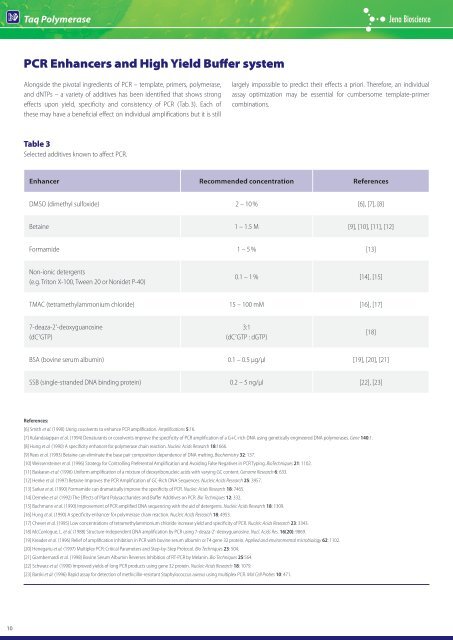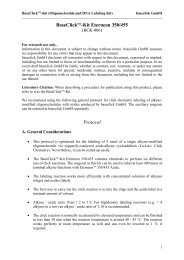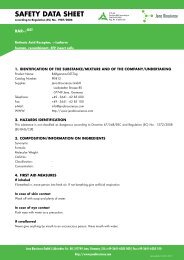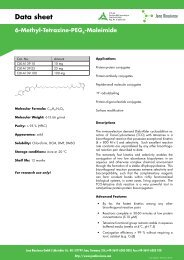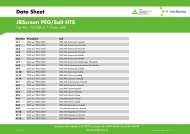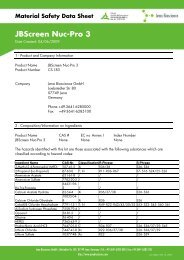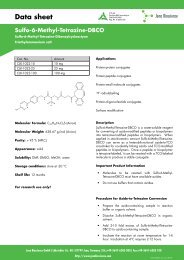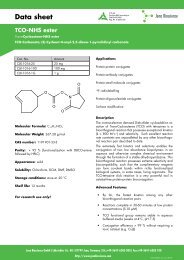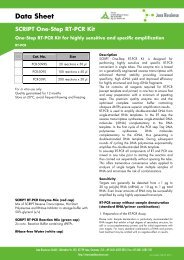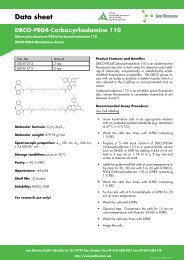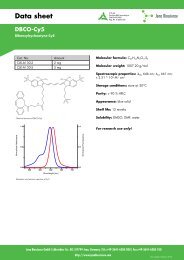Polymerase Guide - Jena Bioscience
Polymerase Guide - Jena Bioscience
Polymerase Guide - Jena Bioscience
You also want an ePaper? Increase the reach of your titles
YUMPU automatically turns print PDFs into web optimized ePapers that Google loves.
10<br />
Taq <strong>Polymerase</strong><br />
PCR Enhancers and High Yield Buffer system<br />
Alongside the pivotal ingredients of PCR – template, primers, polymerase,<br />
and dNTPs – a variety of additives has been identified that shows strong<br />
effects upon yield, specificity and consistency of PCR (Tab. 3). Each of<br />
these may have a beneficial effect on individual amplifications but it is still<br />
Table 3<br />
Selected additives known to affect PCR.<br />
Enhancer Recommended concentration References<br />
DMSO (dimethyl sulfoxide) 2 – 10 % [6], [7], [8]<br />
Betaine 1 – 1.5 M [9], [10], [11], [12]<br />
Formamide 1 – 5 % [13]<br />
Non-ionic detergents<br />
(e.g. Triton X-100, Tween 20 or Nonidet P-40)<br />
0.1 – 1 % [14], [15]<br />
TMAC (tetramethylammonium chloride) 15 – 100 mM [16], [17]<br />
7-deaza-2'-deoxyguanosine<br />
(dC 7 GTP)<br />
largely impossible to predict their effects a priori. Therefore, an individual<br />
assay optimization may be essential for cumbersome template-primer<br />
combinations.<br />
3:1<br />
(dC 7 GTP : dGTP)<br />
BSA (bovine serum albumin) 0.1 – 0.5 µg/µl [19], [20], [21]<br />
SSB (single-stranded DNA binding protein) 0.2 – 5 ng/µl [22], [23]<br />
References:<br />
[6] Smith et al. (1990) Using cosolvents to enhance PCR amplification. Amplifications 5:16.<br />
[7] Kulandaiappan et al. (1994) Denaturants or cosolvents improve the specificity of PCR amplification of a G+C-rich DNA using genetically engineered DNA polymerases. Gene 140:1.<br />
[8] Hung et al. (1990) A specificity enhancer for polymerase chain reaction. Nucleic Acids Research 18:1666.<br />
[9] Rees et al. (1993) Betaine can eliminate the base pair composition dependence of DNA melting. Biochemistry 32: 137.<br />
[10] Weissensteiner et al. (1996) Strategy for Controlling Preferential Amplification and Avoiding False Negatives in PCR Typing. BioTechniques 21: 1102.<br />
[11] Baskaran et al. (1996) Uniform amplification of a mixture of deoxyribonucleic acids with varying GC content. Genome Research 6: 633.<br />
[12] Henke et al. (1997) Betaine Improves the PCR Amplification of GC-Rich DNA Sequences. Nucleic Acids Research 25: 3957.<br />
[13] Sarkar et al. (1990) Formamide can dramatically improve the specificity of PCR. Nucleic Acids Research 18: 7465.<br />
[14] Demeke et al. (1992) The Effects of Plant Polysaccharides and Buffer Additives on PCR. Bio Techniques 12: 332.<br />
[15] Bachmann et al. (1990) Improvement of PCR amplified DNA sequencing with the aid of detergents. Nucleic Acids Research 18: 1309.<br />
[16] Hung et al. (1990) A specificity enhancer for polymerase chain reaction. Nucleic Acids Research 18: 4953.<br />
[17] Chevet et al. (1995) Low concentrations of tetramethylammonium chloride increase yield and specificity of PCR. Nucleic Acids Research 23: 3343.<br />
[18] McConlogue, L. et al. (1988) Structure-independent DNA amplification by PCR using 7-deaza-2'-deoxyguanosine. Nucl. Acids Res. 16(20): 9869.<br />
[19] Kreader et al. (1996) Relief of amplification inhibition in PCR with bovine serum albumin or T4 gene 32 protein. Applied and environmental microbiology 62: 1102.<br />
[20] Henegariu et al. (1997) Multiplex PCR: Critical Parameters and Step-by-Step Protocol. Bio Techniques 23: 504.<br />
[21] Giambernardi et al. (1998) Bovine Serum Albumin Reverses Inhibition of RT-PCR by Melanin. Bio Techniques 25:564.<br />
[22] Schwarz et al. (1990) Improved yields of long PCR products using gene 32 protein. Nucleic Acids Research 18: 1079.<br />
[23] Barski et al. (1996) Rapid assay for detection of methicillin-resistant Staphylococcus aureus using multiplex PCR. Mol Cell Probes 10: 471.<br />
[18]


